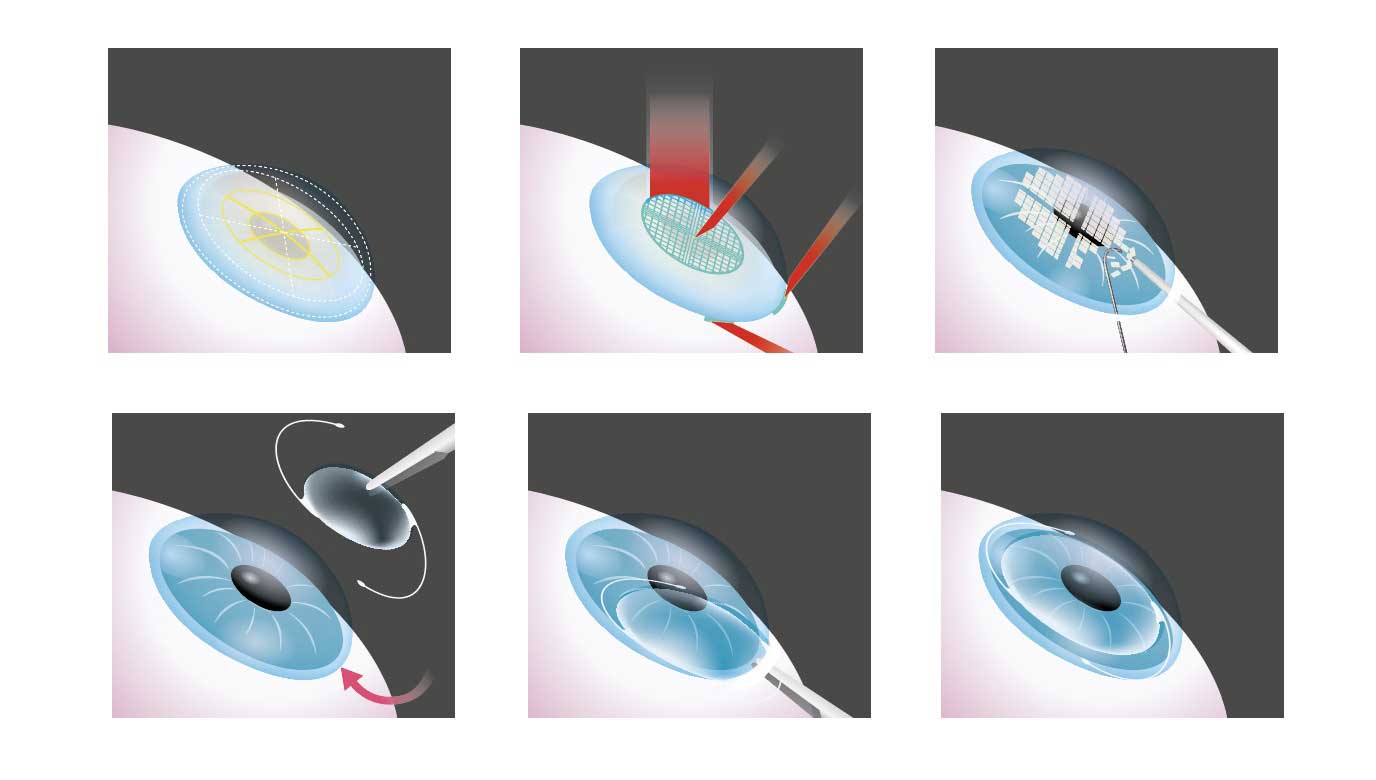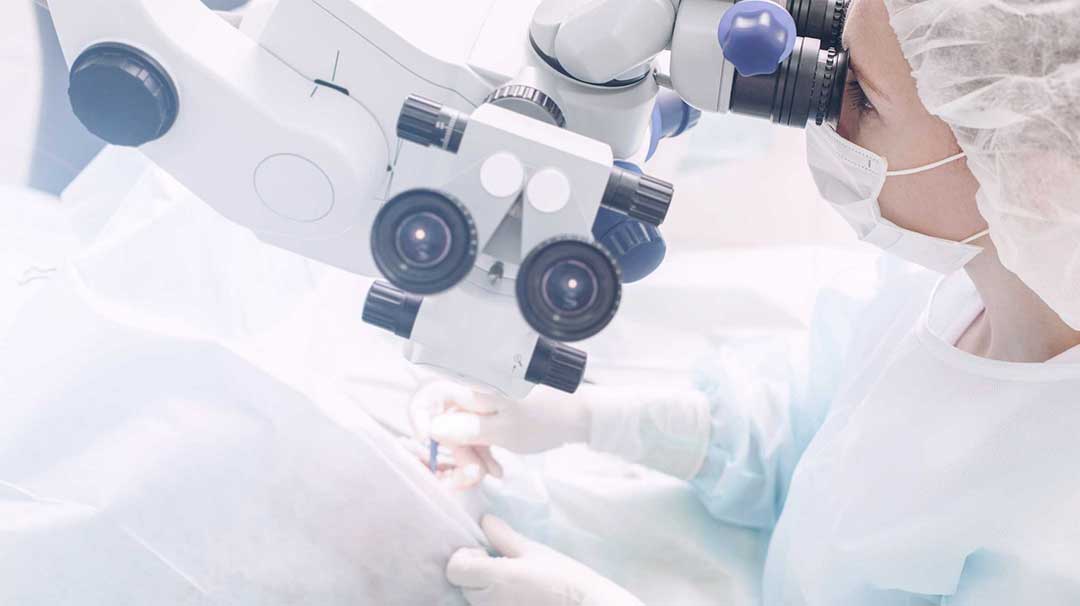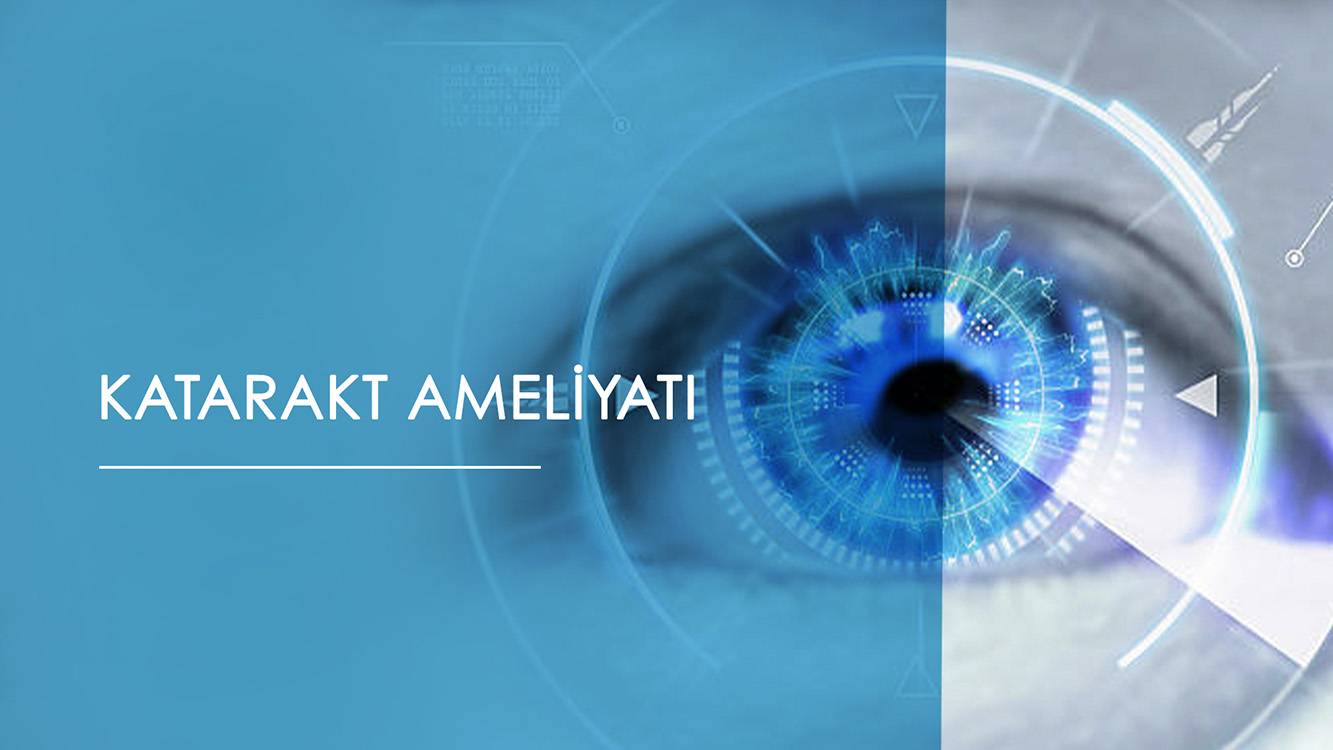Cataract Surgery
Cataract surgery is the process of removing the natural intraocular lens, which has lost its transparency, by various surgical methods and replacing it with an artificial and transparent intraocular lens. The purpose of the operation is to eliminate vision loss due to cataract.
Cataract surgery is an outpatient treatment. It does not require hospital stay, the patient is discharged on the same day. Cataract surgery, which can be performed on both eyes one day apart, takes an average of 15 minutes. It is a procedure usually performed under local anesthesia.

A healthy eye lens is transparent. However, after cataract formation, it loses its transparency over time. As a result, increasing vision loss occurs. In summary, cataract is when the intraocular lens becomes opaque and loses its transparency. Cataract surgery is the only solution to permanently treat this condition.
Cataract surgery is one of the most commonly performed surgeries worldwide, especially for people after the age of 40. This is because cataracts can occur for many genetic and environmental reasons and can occur as a result of aging.
SUBJECT TITLES
- How is Cataract Surgery Performed?
- What should be taken into consideration after the operation?
- What is the Recovery Process After Cataract Surgery?
- Laser Surgery Stages
- Phases of Phacoemulsification Surgery
- Stages of Extra Capsular Surgery
- Cataract Surgery Applications
- Which Lenses Are Used in the Operation?
- How to Decide on the Lens to be Used in the Operation?
- What is the Pre-Operative Process?
- What are the Types of Cataract Surgery?
- In what cases is cataract surgery performed?
- Frequently Asked Questions About Cataract Surgery
How is Cataract Surgery Performed?
Although there are different techniques in cataract surgery, there is a common purpose for all of them. Cataract operation is a microsurgical procedure that is an eye surgery. All operations are performed under a microscope with the help of very small instruments.
The average duration of cataract surgery is between 10-15 minutes, depending on the hardness of the cataract in the intraocular lens. The general application stages of the surgery are as follows:
- Before the surgery, drops are instilled into the eye to dilate the pupil. At this stage, if deemed appropriate by the doctor, the patient may be sedated.
- The patient is taken to the operating room and allowed to lie on the operating bed. After a sterile dressing is covered over and around the eye, anesthetic drops are dropped into the eye so that the patient does not feel anything during the operation. The patient is asked to constantly look at a constant light directly above the eye.
- The cataractous natural eye lens is removed from the eye using various techniques through small incisions made outside the eye.
- During the surgery, prior advice from the doctor and the patient An artificial and transparent intraocular lens, determined according to the patient's choice, is placed in the patient's eye
- Some types of cataract surgery require stitches, while others do not.
- At the end of the operation, the eye is closed with a protective tape
CLICK TO MAKE A QUICK APPOINTMENT WITH OUR EYE DOCTORS
What should be taken into consideration after the operation?
Things to pay attention to after cataract surgery are as follows:
- Patient's opinion should not drive until complete recovery
- Regular doctor's check-ups should not be neglected at the intervals specified by the doctor
- Care should be taken to regularly use the eye drops prescribed by the doctor. This speeds up the healing process and also reduces the risk of eye infection.
- Do not take a shower for the first few days. Afterwards, care should be taken to avoid contact with water in the eyes for about a month. Avoid entering the pool or sauna for about 1 month. Eyes should be protected from the risk of infection.
- Eyes should not be rubbed and should be protected from impact.
- Sleep with protective glasses for the period specified by the doctor.
- Do not go out during peak daylight hours. People should not go out, and even if they do, sunglasses should be used.
- Sports should not be done or heavy work should be done in the first week.
- Due to the risk of infection, eyes should be protected against water, dirt and dust.
What is the Recovery Process After Cataract Surgery?
There is no need to stay in hospital after cataract surgery. The patient is discharged within an hour after being kept under observation for a certain period of time. After cataract surgery the following symptoms may be observed during the recovery process:
- In the first few days after the surgery, the lights are brighter and the colors are brighter. It is normal to see sharper.
- Blurry in vision may be seen during the first week. Most patients see much better immediately after the operation. However, it may take up to 2 months for vision quality to reach maximum level.
- Redness, itching and watering in the eyes are normal for the first week. However, when this situation reaches a level that bothers the patient along with the pain, an ophthalmologist should be consulted.

Laser Surgery Stages
Surgical incisions are opened with the help of laser beams, and laser beams are also used at certain stages, especially in the disintegration of the cataractous natural lens. The cataractous intraocular lens is cleaned with a phaco device. In the final stage of the operation, an artificial intraocular lens is placed. Laser cataract surgery is not suitable for every case.
Phases of Phacoemulsification Surgery
Among the cataract surgery methods, the Phaco method is the most used method today. In this method, a small incision is made into the eye and the cataractous natural eye lens is shattered with the help of high-frequency ultrasonic sound waves. Then, these parts are removed and cleaned with the help of vacuum.
Finally, the artificial intraocular lens, which is folded and placed inside the eye, is placed. Since the incision area is very small, it is not a method that requires stitches. It is a cataract surgery method in which recovery is rapid and the risk of complications is low.
Stages of Extra Capsular Surgery
In this surgery, a large incision is made in the cornea. Through this incision, the cataractous eye lens is removed with vacuum. Then, an artificial eye lens is placed through the same incision. In this type of cataract surgery, the eye lens is not disintegrated and is removed as an additional piece.
Finally, the operation is completed by suturing the corneal opening. It is a method generally applied in special cases. Recovery is slower than the phaco method.
Cataract Surgery Applications
Cataract surgery varies in procedure depending on the type of operation performed.

Which Lenses Are Used in the Operation?
Three different types of intraocular lenses can be applied during cataract surgery.
Monofocal Lenses: This type of lens is also known as fixed focus lens. There is clear vision for either distance or near vision. It is applied to most people for distance vision clarity. Patients have to use glasses after the operation for near vision and intermediate distances.
Bifocal Lenses:They allow focusing at both near and far distances. The need for glasses may arise for medium distances.

Trifocal Lenses (Smart Lenses): Widely used in cataract surgery applications and smart lenses, patients can obtain clear vision at both near, far and intermediate vision distances. Thus, the patient's need for glasses is completely eliminated after the operation. Smart lenses work like natural intraocular lenses and can transmit light coming from all distances to the retina.
Apart from all these lenses that can be applied to cataract patients, Toric lenses and Add-on intraocular lens applications can also be applied to patients requiring different treatments. .
Toric Lenses: Toric lenses are intraocular lenses applied to people who have cataracts but also have astigmatism problems.
Add-on. Lenses: Add-on lenses are lenses that allow patients who have previously undergone cataract surgery and had a single-focus lens placed to see all three focuses clearly by placing them in the eye as a second lens.
How to Decide on the Lens to be Used in the Operation?
During the examinations before cataract surgery, it can be decided which lens will be used instead of the patient's natural intraocular lens. In these examinations, the refraction of the natural lens inside the eye is measured by biometry and corneal thickness is measured by keratometry. Additionally, the patient's eye size and shape are measured through various examinations. According to the results of these, a lens suitable for the patient's eye number can be selected.
When choosing the intraocular lens to be applied during the operation, one of the various lens types is recommended by the ophthalmologist, taking into account the patient's lifestyle and habits, as well as the suitability of the patient's eye structure and general eye health. .
What is the Pre-Operative Process?
The decision on cataract surgery can be made as a result of various tests to detect the disease. Before planning cataract treatment, a comprehensive eye examination is performed by the physician to determine general eye health.
Again, at this stage, the patient is diagnosed with presbyopia and It can be revealed whether the eye has one of the refractive errors. Because if the patient has astigmatism, it would be appropriate to choose a lens that will also treat astigmatism.
The most important point before cataract surgery is to determine whether the patient will see well after the surgery. At this stage, the patient's retina is examined with a test called OCT.
The power of the intraocular lens is determined by biometry and keratometry. Corneal thickness is also measured. Thanks to these measurements, intraocular lens selection can be made according to the patient's eye structure and needs.
What are the Types of Cataract Surgery?
The basic procedure for cataract surgery is to clean the cataractous natural intraocular lens and replace it with an artificial intraocular lens. Depending on the type of artificial intraocular lens placed in the eye, patients can continue their lives with or without glasses.
Cataract surgery types have diversified day by day with the advancement of technology. Although the phaco method is frequently used as one of the latest methods for surgery, other older methods can be used in some cases for suitable patients. The important point here is the success of the treatment with the method to be applied. That is, to eliminate the risk of complications during and after the operation and to maximize the patient's vision with the newly placed intraocular lens.
There are 3 different types of cataract surgery. These are;
- Extra Capsular Cataract Surgery
- Phacoemulsification Cataract Surgery
- Laser Cataract Surgery
In what cases is cataract surgery performed?
Cataract surgery is performed for the permanent treatment of cataract disease. Treatment of the disease with medication other than surgery is not a permanent solution. Drug treatment is only a solution to slow down the progression of the disease.
Cataract can occur due to environmental factors and genetic reasons, and generally occurs as a result of aging. Cataract formation is a gradual process that occurs over many years.
Cataract usually progresses slowly from the initial stage to the advanced level. After cataract formation, blurred vision and decreased visual acuity manifest themselves in the later stages of the process. Patients can usually continue their daily activities by using prescription glasses and with better lighting in the initial stages.
When the disease reaches an advanced stage, the person will be able to continue their daily activities such as reading a book, driving a car, doing tasks that require detailed vision in dim light, and other daily activities. He starts to have difficulty doing it alone. When the progression of the disease reaches this stage, surgery is the only permanent solution for the patient. In this way, it is aimed to increase the patient's quality of life.
The decision to have cataract surgery can be made with the doctor's advice as a result of various examinations. The important point here is to what extent cataract affects the person's quality of life.
Frequently Asked Questions About Cataract Surgery
There are many questions that patients wonder about what happens during the operation process and the recovery process afterwards.
Is Cataract Surgery Risky?
Like every surgical procedure, cataract surgery also has certain risks. Since the operation is microsurgical, the success of the surgery is directly related to the selection of the appropriate method for the appropriate patient, the experience of the ophthalmologist, the quality of the materials and the sterilization of the operating room environment.
https://www.youtube.com/watch?v= nM5w5WP4L4k
Cataract surgery is one of the operations with a high overall success rate. However, despite all this, there are some risks, especially in patients with hard cataracts and the elderly.
Cataract Surgery Prices
Pricing prices for cataract surgery on the internet is against healthcare industry procedures. It is also not in compliance with ethical rules.
Cataract surgery prices depends on the method to be applied for the operation and the brand and type of intraocular lens to be used. It varies depending on the patient.
